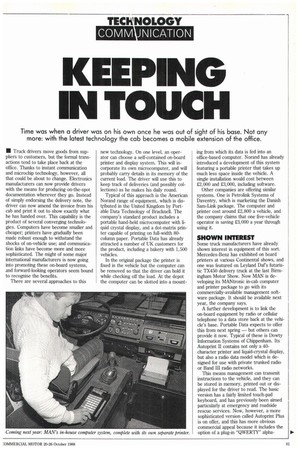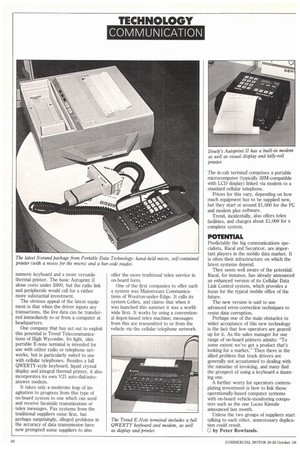KEEPING IN TOUCH
Page 47

Page 48

If you've noticed an error in this article please click here to report it so we can fix it.
Time was when a driver was on his own once he was out of sight of his base. Not any more: with the latest technology the cab becomes a mobile extension of the office.
• Truck drivers move goods from suppliers to customers, but the formal transactions tend to take place back at the office. Thanks to instant communication and microchip technology, however, all that could be about to change. Electronics manufacturers can now provide drivers with the means for producing on-the-spot documentation wherever they go. Instead of simply endorsing the delivery note, the driver can now amend the invoice from his cab and print it out to show exactly what he has handed over. This capability is the product of several converging technologies. Computers have become smaller and cheaper; printers have gradually been made robust enough to withstand the shocks of on-vehicle use; and communication links have become more and more sophisticated. The might of some major international manufacturers is now going into promoting these on-board systems, and forward-looking operators seem bound to recognise the benefits.
There are several approaches to this new technology. On one level, an operator can choose a self-contained on-board printer and display system. This will incorporate its own microcomputer, and will probably carry details in its memory of the current load. The driver will use this to keep track of deliveries (and possibly collections) as he makes his daily round.
Typical of this approach is the American Norand range of equipment, which is distributed in the United Kingdom by Portable Data Technology of Bracknell. The company's standard product includes a portable hand-held microcomputer with liquid crystal display, and a dot-matrix printer capable of printing on full-width 80column paper. Portable Data has already attracted a number of UK customers for the product, including a bakery with 1,500 vehicles.
In the original package the printer is fixed in the vehicle but the computer can be removed so that the driver can hold it while checking off the load. At the depot the computer can be slotted into a mount ing from which its data is fed into an office-based computer. Norand has already introduced a development of this system featuring a portable printer that takes up much less space inside the vehicle. A single installation would cost between £2,000 and 23,000, including software.
Other companies are offering similar systems. One is Petrolink Systems of Daventry, which is marketing the Danish Sam-Link package. The computer and printer cost around 22,800 a vehicle, and the company claims that one five-vehicle operator is saving £3,000 a year through using it.
SHOWN INTEREST
Some truck manufacturers have already shown interest in equipment of this sort. Mercedes-Benz has exhibited on board printers at various Continental shows, and one was featured on Leyland Daf's futuristic TX450 delivery truck at the last Birmingham Motor Show. Now MAN is developing its MANtronic in-cab computer and printer package to go with its commercially-available management software package. It should be available next year, the company says.
A further development is to link the on-board equipment by radio or cellular telephone to a data store back at the vehicle's base. Portable Data expects to offer this from next spring — but others can provide it now. Typical of these is Dowty Information Systems of Chippenham. Its Autoprint II contains not only a 40character printer and liquid-crystal display, but also a radio data model which is designed for use with private trunked radio or Band III radio networks.
This means management can transmit instructions to the vehicle, and they can be stored in memory, printed out or displayed for the driver to read. The basic version has a fairly limited touch-pad keyboard, and has previously been aimed particularly at emergency and roadside rescue services. Now, however, a more sophisticated version called Autoprint Plus is on offer, and this has more obvious commercial appeal because it includes the option of a plug-in "QWERTY" alpha numeric keyboard and a more versatile thermal printer. The basic Autoprint 11 alone costs under 2600, but the radio link and peripherals would call for a rather more substantial investment.
The obvious appeal of the latest equipment is that when the driver inputs any transactions, the live data can be transferred immediately to or from a computer at headquarters.
One company that has set out to exploit this potential is Trend Telecommunications of High Wycombe. Its light, slim portable E-note terminal is intended for use with either radio or telephone networks, but is particularly suited to use with cellular telephones. Besides a full QWERTY-style keyboard, liquid crystal display and integral thermal printer, it also incorporates its own V21 auto-dial/autoanswer modem.
It takes only a moderate leap of imagination to progress from this type of on-board system to one which can send and receive facsimile transmissions or telex messages. Fax systems from the traditional suppliers came first, but perhaps surprisingly, alleged problems in the accuracy of data transmission have now prompted some suppliers to also offer the more traditional telex service in on-board form.
One of the first companies to offer such a system was Mainstream Communications of Wootton-under-Edge. It calls its system Cellex, and claims that when it was launched this summer it was a worldwide first. It works by using a conventional depot-based telex machine; messages from this are transmitted to or from the vehicle via the cellular telephone network. The in-cab terminal' comprises a portable microcomputer (typically IBM-compatible with LCD display) linked via modem to a standard cellular telephone.
Prices for this vary, depending on how much equipment has to be supplied new, but they start at around 21,000 for the PC and modem plus software.
Trend, incidentally, also offers telex facilities, and charges about 21,000 for a complete system.
POTENTULL
Predictably the big communications specialists, Racal and Securicor, are important players in the mobile data market. It is often their infrastructure on which the latest systems depend.
They seem well aware of the potential; Racal, for instance, has already announced an enhanced version of its Cellular Data Link Control system, which provides a focus for the typical mobile office of the future.
The new version is said to use advanced error-correction techniques to resist data corruption.
Perhaps one of the main obstacles to wider acceptance of this new technology is the fact that few operators are geared up for it. As the sales manager for one range of on-board printers admits: "To some extent we've got a product that's looking for a market." Then there is the allied problem that truck drivers are generally not accustomed to dealing with the minutiae of invoicing, and many find the prospect of using a keyboard a daunting one.
A further worry for operators contemplating investment is how to link these operationally-based computer systems with on-board vehicle-monitoring computers such as the one Lucas Kienzle announced last month.
Unless the two groups of suppliers start talking to each other, unnecessary duplication could result.
CI by Peter Rowlands.






























































